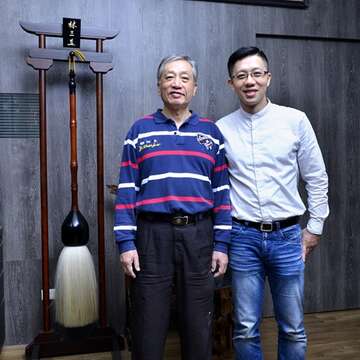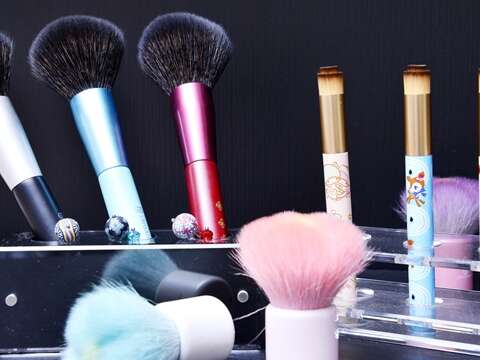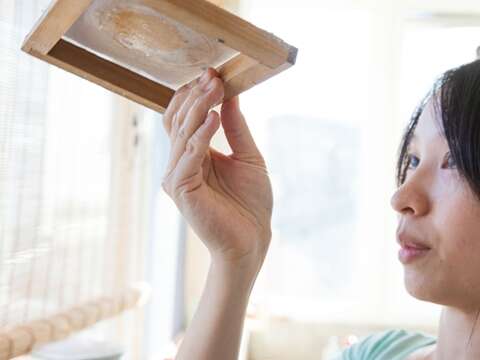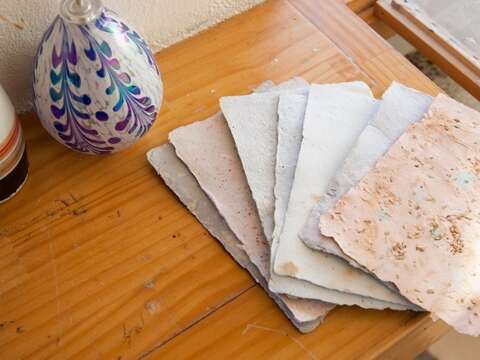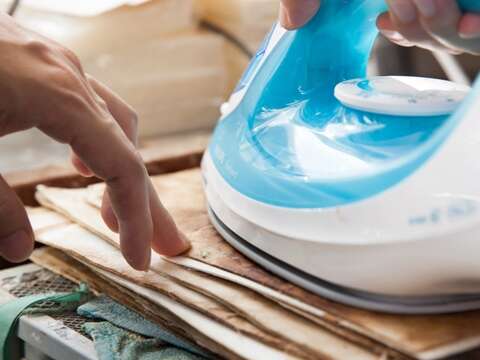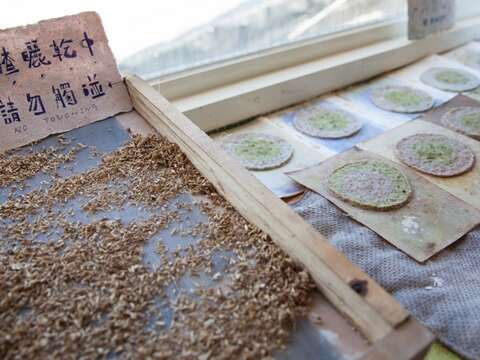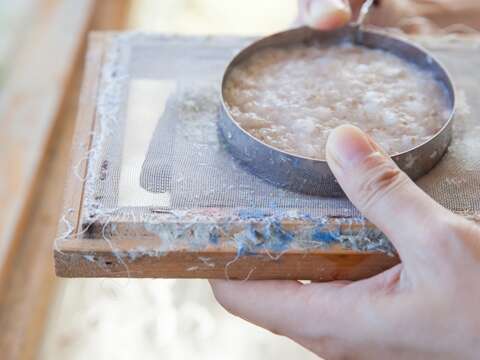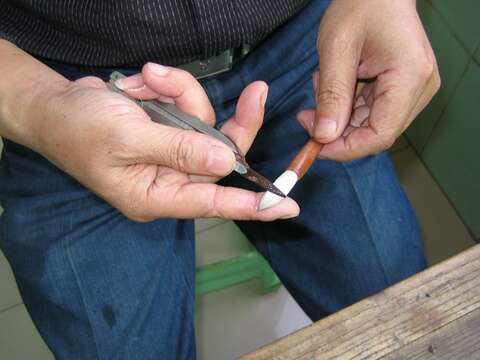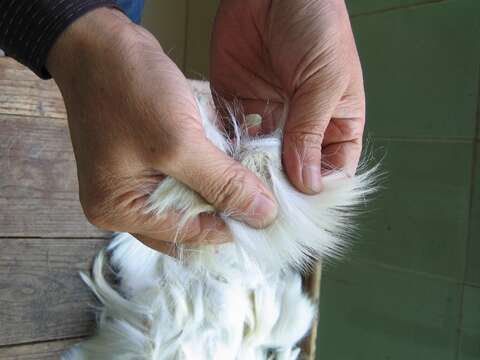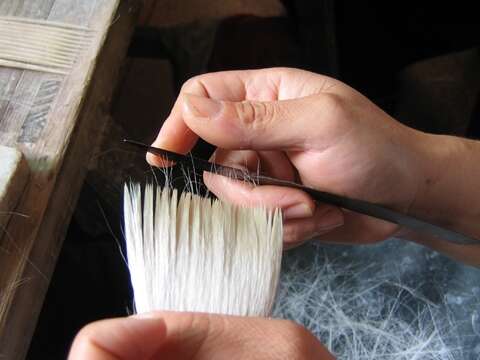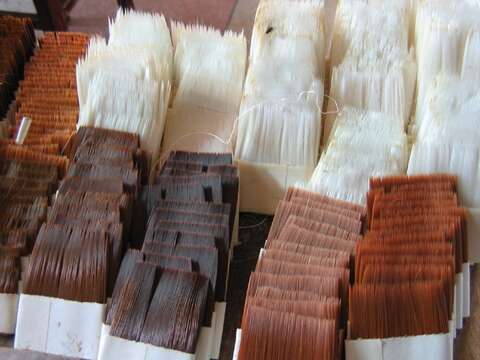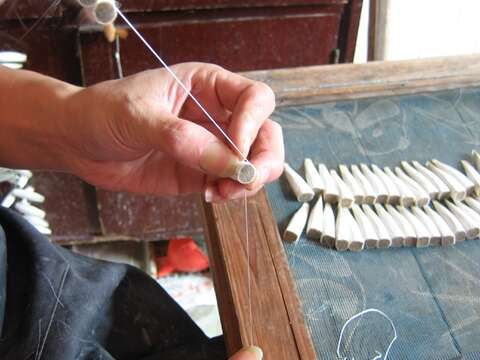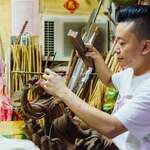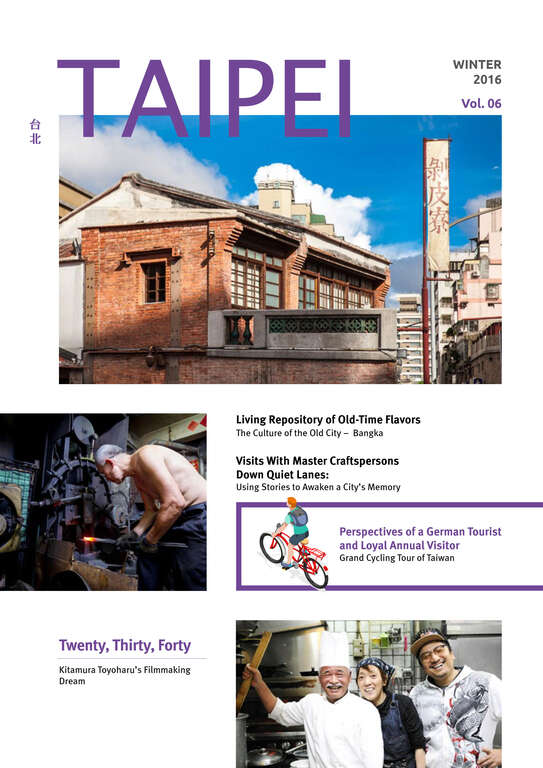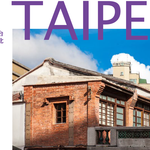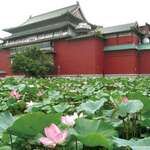Post date:2017-03-10
2140
Meng’s Handmade Paper & Lam Sam Yick Calligraphy Brushes
Traditional Crafts – Writing a New Page in Taiwan’s Memory
Article_Fan Yujie
Photos_Wu Jinshi, Shi Chuntai
Each day, we continually check our cellphones and spend much time on our computers, as if we have already forgotten the warmth and emotion of writing by hand. However, there is a group of people who, due to their love of the unique qualities of handmade paper and writing instruments, have learned traditional production methods and have even endowed them with novel meaning, bringing new life to ancient crafts.
Handmade Paper – A Warmth That Technology Cannot Replace
The warmth and positive feeling associated with paper can never be replaced by high-tech products. Due to her sentimental attachment to paper Li Meng-Shu (李孟書), the founder of Meng’s Handmade Paper (二皿手作紙設計), quit her stable teaching job to devote herself to the research and development of handmade paper. She creates unique postcards, paper necklaces, and paper lamps. Hers is one of Taiwan’s few paper-based cultural-creative brands.
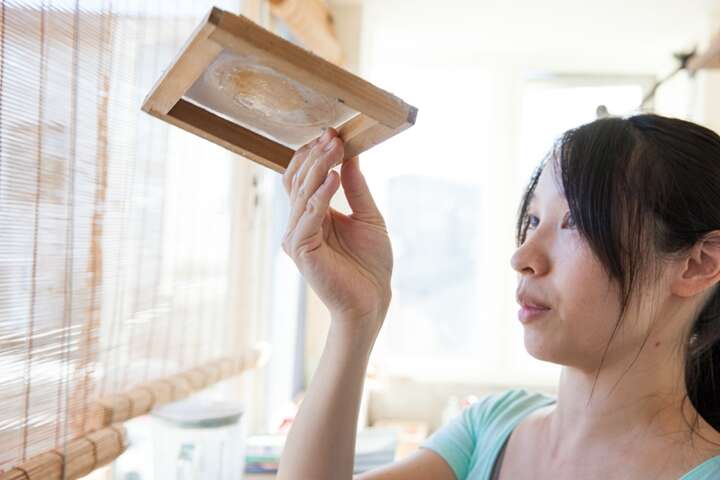
▲ From the handmade details, the dedication of Li Meng-Shu is clear. (Photo: Shi Chuntai )
Her education in fine arts began in junior high school, which she studied all the way through graduate school. Since the beginning, Li has dedicated herself to the art and design fields. She talks about the first time that she came in contact with handmade paper. It was in elementary school, when she used xuan zhi (Chinese rice paper) for calligraphy. As she was just a child, she wasn’t deeply affected by that experience. In graduate school, as she was searching for a thesis topic, she knew that she wanted to focus on the cultural-creative industry. She used pineapple fiber to create paper boxes, and traveled to the Philippines to visit a Taiwanese-owned paper factory. This was when she first understood that there are many methods for making paper. It also marked the birth of the idea of making paper art her profession.
After that experience, Li began learning how to make paper on her own. She started by gathering information and making videos of the methods used by a master paper artist, then attempted to use different materials and papermaking techniques on her own. After a period of continuous practice, she gradually mastered the characteristics of each type of paper, and began producing the results that she wanted. After receiving her graduate degree, Li taught high school advertising design courses, but in her heart was the desire to produce paper. She resolutely quit her stable teaching position, and opened Meng’s Handmade Paper at the Treasure Hill Artist Village (寶藏巖國際藝術村) in 2010. This began a tug-of-war between her ideals and her reality, for in addition to focusing on paper making and design, she also had to slowly learn how to manage and operate her workshop.
Infused With Design Elements, Creating a New Soul for Papermaking
Li loves the warmth of paper. Through touch and visual expression, each piece of paper can convey a different type of esthetics. At the same time, through design and innovation, paper can appear rich and refined. She believes that paper has a very gentle quality. “Take lampshades and screens as examples. By using paper, the light becomes pleasantly warm, and no longer as intense.”
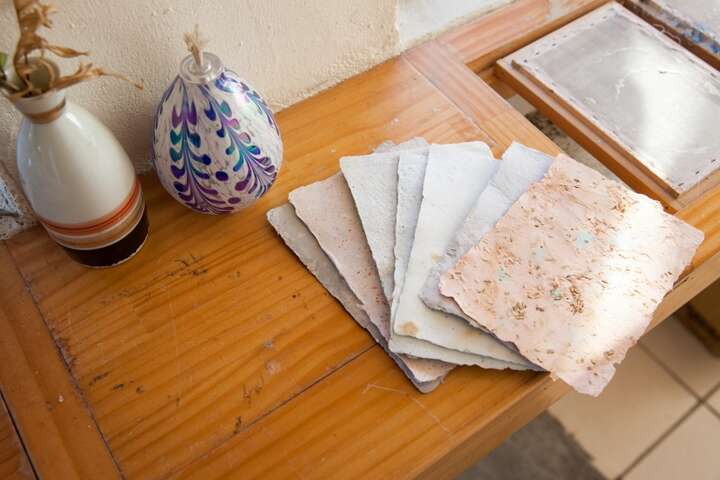
▲ Traditional papermaking techniques infused with new design meaning result in cultural-creative products. (Photo: Shi Chuntai )
In contrast to traditional papermaking artisans, Li brings her design talent into play to create new life for handmade paper and to lead in reacquainting the public with handmade paper. She also infuses paper with the concepts of daily use and practical function. In addition to the familiar notebooks and cards, she transforms handmade paper into such things as coasters, lampshades, screens, partitions, and wrapping paper to embellish home decor.
More than 90 percent of the materials for her creations come from easily accessible resources, such as corrugated paper, milk cartons, and discarded paper towels. These are materials that were originally going to be thrown out. Instead, they are made into environmentally friendly paper pulp. She has even used wheat dregs left over from the production of liquor to make paper packaging for distillery designed products, and she develops products for local farmers. The shells of locally produced bamboo shoots are among the environmentally friendly local materials that she accesses.
In addition to operating her Treasure Hill Artist Village workshop on weekends, Li has a space in the Eslite Spectrum Songyan Store (誠品生活松菸店). Through her papermaking classes, she connects with different groups of people, such as families, domestic and foreign travelers, handicrafts lovers, and hipsters. She also volunteers at homes for the physically and mentally challenged, as well as organizations that help the underprivileged, teaching papermaking. Li hopes to plant seeds that encourage others to teach underprivileged children, enabling them to bring their creativity into play and, at the same time, improve their finger dexterity through practice.
Insisting on completely MIT (made in Taiwan) paper, she will continue to search for plants native to Taiwan that can be used as materials, to infuse her handmade paper with even more uniquely local character.
Meng’s Handmade Paper
二皿手作紙設計
Treasure Hill Artist Village; 2, Aly. 59, Ln. 230, Sec. 3, Tingzhou Rd. (寶藏巖國際藝術村;汀洲路3段230巷59弄2號)
(02)2364-5313, ext. 314
Fri~Sun 12:00~22:00
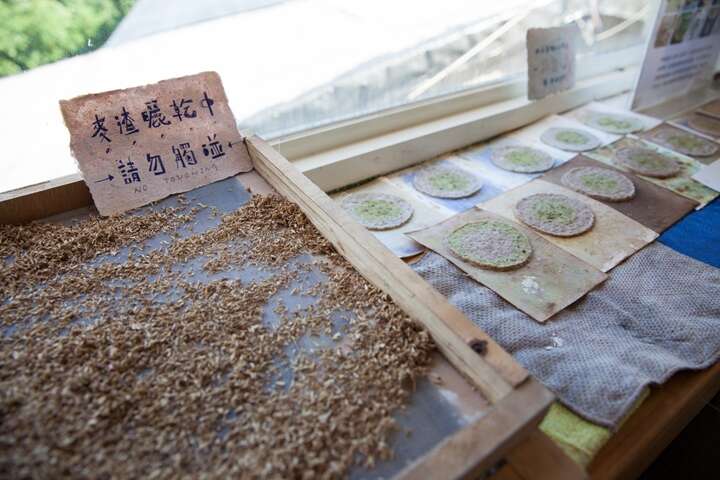
▲ 1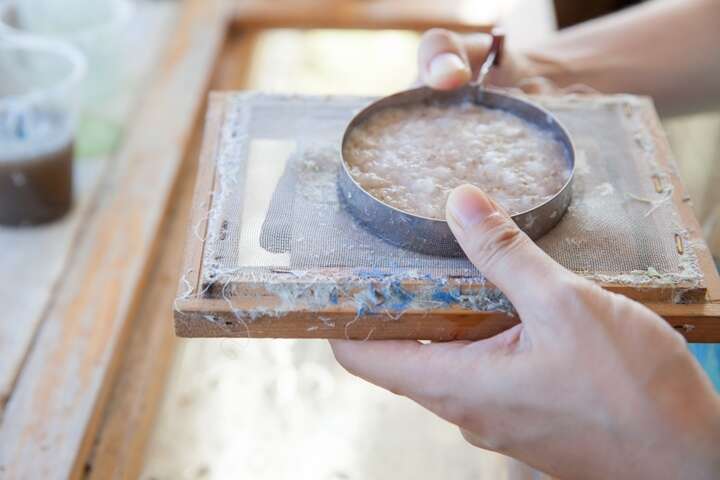
▲ 2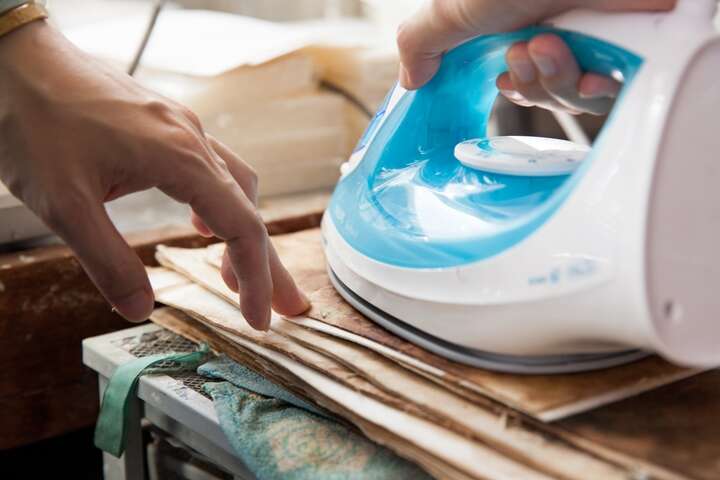
▲ 3
Process of Making a Coaster From Wheat Dregs
1. Place sun-dried wheat dregs and waste paper into a blender. Add water and blend to produce pulp.
2. Add glue and evenly spread out the pulp. Then place the pulp on a papermaking frame and drain away the water. Use an egg-frying mold to fix the shape.
3. Use absorbent paper to absorb any excess moisture.
4. Finally, press flat with an iron.
Century-Old Brand, From Calligraphy to Cosmetics Brushes
Along the quaint streets of Dadaocheng stand many century-old stores. Among them is Lam Sam Yick (林三益). Due to its sophisticated and complicated production process, this store has become synonymous with handmade calligraphy brushes. Walking inside, there is an assortment of calligraphy brushes, cups for adding water to inkstones, inkstones, name chops, and Shoushan stone carvings on display. The space is infused with an elegant Asian style. Strewn throughout another area of the store is a diversity of makeup brushes, such as eye shadow, powder, and acne brushes, creating an air of fashion. Writing materials and cosmetics brushes – these symbolize the successful coexistence of the traditional and the modern.
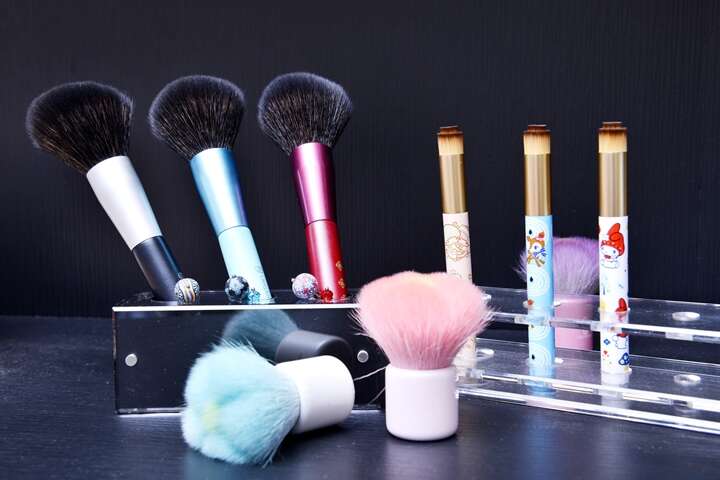
▲ Lam Sam Yick has passed down calligraphy brush-making methods over the past century. In recent years, it has collaborated with Sanrio to successfully enter the cosmetics market. (Photo: Wu Jinshi)
The story of the Lam Sam Yick brand can be traced to the late Qing dynasty. At that time, the production of writing implements was the least expensive craft trade to learn. The first-generation owner, Lin Wanwu (林萬務), became proficient in this craft. In his hometown of Fuzhou, mainland China, he served as an apprentice and learned how to produce calligraphy brushes at a shop, the first two characters of which were Sam Yick (三益). After completing his training he continued to work in his former master’s store, then after several years opened his own. To show his gratitude, he named it Lam Sam Yick (the surname “Lin” is Mandarin Chinese; “Lam” is the Fujianese). In 1946 he moved his family to Taipei, continuing to build the Lam Sam Yick brand in Dadaocheng and becoming a well-known calligraphy brush and ink family business.
48-Step Production Process – Ingenious Perfection of Brush Points
How can we define a good calligraphy brush? Lin Changlong (林昌隆), the fourth-generation manager of Lam Sam Yick, says that the brush materials and components must be correct and in the right proportions, and the point where the brush tip is formed must be smooth and flexible to allow the user to freely and smoothly write or paint. He emphasizes that at least 48 steps are required to produce a handmade calligraphy brush. Each step must be carried out by a master brush maker, who checks every detail. The quality of the brush depends on the master worker’s skill and attention to detail.
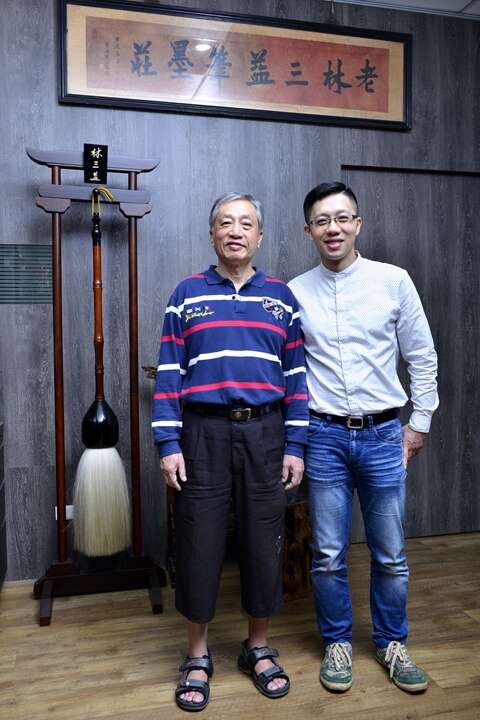
▲ In the face of changing times, father and son have persisted in the spirit of traditional craftsmanship while extending it to modern makeup brushes. (Photo: Wu Jinshi)
The process begins with choosing the hairs. Hairs without natural tips are removed. Those remaining are combined and any down is removed. They are then arranged, the composition of the hairs is completed, and the shape of the brush is set. The hairs are thereafter combed neatly and rolled around the core, wrapped, and bound in place. Following this strict process, if the brush passes the quality-control check a handle is chosen based on material and form, for example ox horn, silver, or porcelain, to increase the beauty of the brush.
Sticking to One’s Roots – Respecting Tradition Yet Welcoming Innovation
With the changing times, the number of people practicing Chinese calligraphy has been on the decline. Added to this is the elimination of calligraphy from the junior high school curriculum. In 1996, Lin Changlong took over the brand, and to enable the store to continue operating, he visited stationery stores, bookstores, and Buddhist-implement stores in an attempt to open new markets. The response was always the same: “There is no demand, there is no sales volume. We don’t need to stock this!”
Searching for his breakthrough, Lin Changlong received inspiration from a nail-art salon. He decided to develop makeup brushes for salons, and in 2008 entered the market with the launch of the LSY brand. With a hundred-year-old foundation of expertise in making brushes by hand, rich knowledge of materials, and an insistence on quality, Lam Sam Yick has maintained its traditional craft-making spirit while developing new types of brushes. Innovative marketing methods have also been introduced. For example, in recent years this brand has worked with Sanrio to create Hello Kitty calligraphy and makeup brushes. In addition, Taiwanese indigenous motifs have been added to the cloth covers of makeup-brush sets, resulting in successful entry into the cosmetics market and products coveted by the public.
From Lam Sam Yick, expert in calligraphy items, to LSY, expert in makeup brushes, this 100-year-old shop has undergone a successful transformation. With its product positioning in “brush writing instruments,” tradition and innovation have both moved in parallel and intersected. In the future, in addition to continuing to develop the makeup-brush market, Lam Sam Yick will work to promote calligraphy culture. Plans are underway to offer courses that will help students in achieving inner calm through the practice of calligraphy. The Lam Sam Yick official website will also be launched, in the continuing effort to infuse this century-old brand with new life.
Lam Sam Yick (LSY)
林三益筆墨專家
58, Sec. 2, Chongqing N. Rd. (重慶北路2 段58 號)
(02)2556-6433
Mon~Sat 09:00~18:00
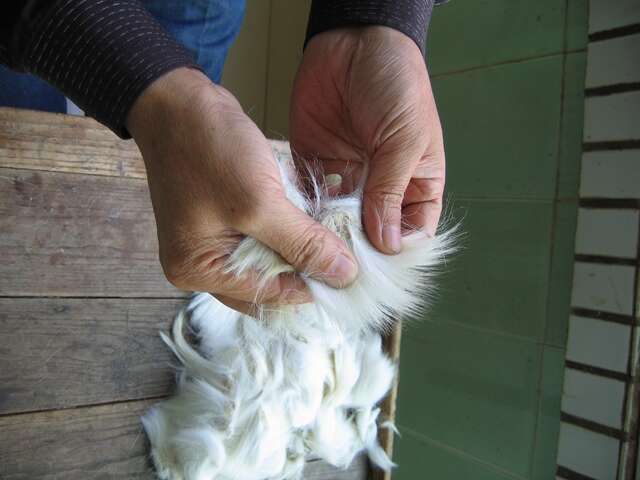
▲ 1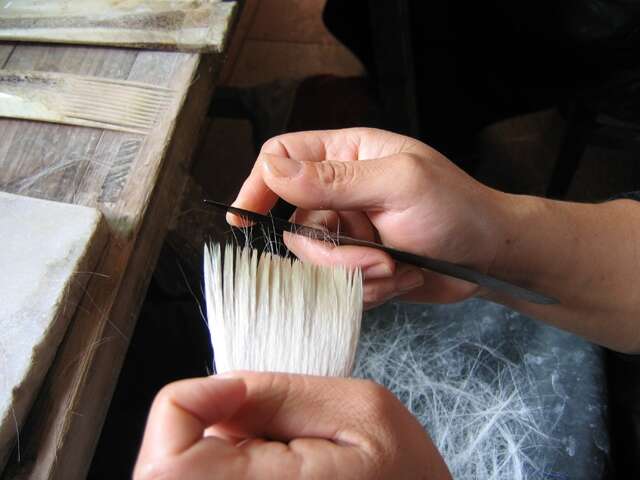
▲ 3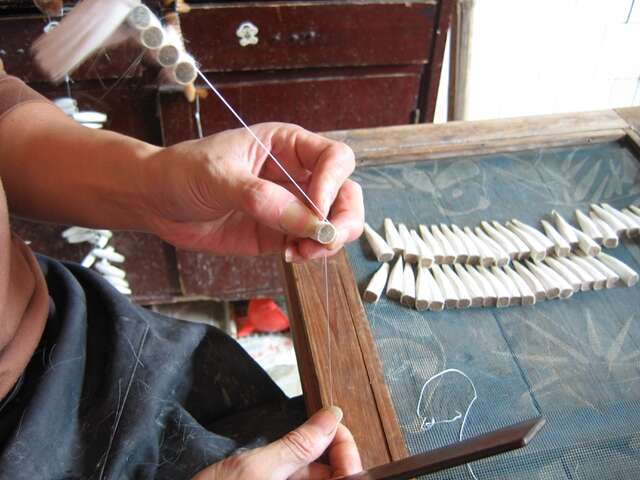
▲ 6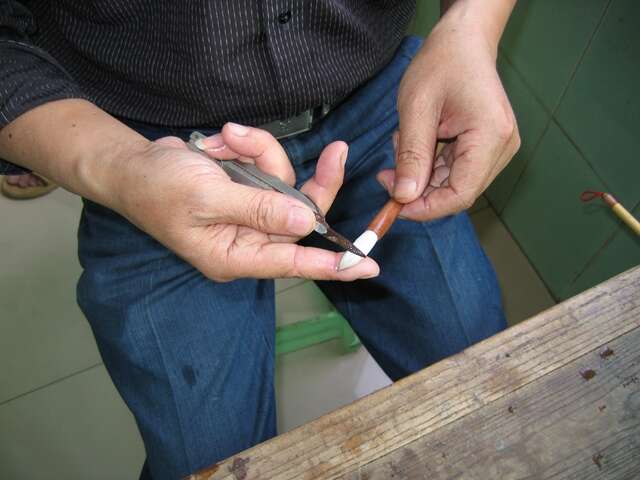
▲ 7
Process for Making Calligraphy Brushes
1. Choose hairs.
2. Align hair tips.
3. Eliminate hairs with relatively short and fine tips.
4. Align hairs using comb.
5. Arrange into the shape of the brush.
6. After binding brush head, connect strands.
7. After wrapping around handle, carry out final trimming.
8. Finally, fix with addition of glue.
Traditional Crafts – Writing a New Page in Taiwan’s Memory
Article_Fan Yujie
Photos_Wu Jinshi, Shi Chuntai
Each day, we continually check our cellphones and spend much time on our computers, as if we have already forgotten the warmth and emotion of writing by hand. However, there is a group of people who, due to their love of the unique qualities of handmade paper and writing instruments, have learned traditional production methods and have even endowed them with novel meaning, bringing new life to ancient crafts.
Handmade Paper – A Warmth That Technology Cannot Replace
The warmth and positive feeling associated with paper can never be replaced by high-tech products. Due to her sentimental attachment to paper Li Meng-Shu (李孟書), the founder of Meng’s Handmade Paper (二皿手作紙設計), quit her stable teaching job to devote herself to the research and development of handmade paper. She creates unique postcards, paper necklaces, and paper lamps. Hers is one of Taiwan’s few paper-based cultural-creative brands.

▲ From the handmade details, the dedication of Li Meng-Shu is clear. (Photo: Shi Chuntai )
Her education in fine arts began in junior high school, which she studied all the way through graduate school. Since the beginning, Li has dedicated herself to the art and design fields. She talks about the first time that she came in contact with handmade paper. It was in elementary school, when she used xuan zhi (Chinese rice paper) for calligraphy. As she was just a child, she wasn’t deeply affected by that experience. In graduate school, as she was searching for a thesis topic, she knew that she wanted to focus on the cultural-creative industry. She used pineapple fiber to create paper boxes, and traveled to the Philippines to visit a Taiwanese-owned paper factory. This was when she first understood that there are many methods for making paper. It also marked the birth of the idea of making paper art her profession.
After that experience, Li began learning how to make paper on her own. She started by gathering information and making videos of the methods used by a master paper artist, then attempted to use different materials and papermaking techniques on her own. After a period of continuous practice, she gradually mastered the characteristics of each type of paper, and began producing the results that she wanted. After receiving her graduate degree, Li taught high school advertising design courses, but in her heart was the desire to produce paper. She resolutely quit her stable teaching position, and opened Meng’s Handmade Paper at the Treasure Hill Artist Village (寶藏巖國際藝術村) in 2010. This began a tug-of-war between her ideals and her reality, for in addition to focusing on paper making and design, she also had to slowly learn how to manage and operate her workshop.
Infused With Design Elements, Creating a New Soul for Papermaking
Li loves the warmth of paper. Through touch and visual expression, each piece of paper can convey a different type of esthetics. At the same time, through design and innovation, paper can appear rich and refined. She believes that paper has a very gentle quality. “Take lampshades and screens as examples. By using paper, the light becomes pleasantly warm, and no longer as intense.”

▲ Traditional papermaking techniques infused with new design meaning result in cultural-creative products. (Photo: Shi Chuntai )
In contrast to traditional papermaking artisans, Li brings her design talent into play to create new life for handmade paper and to lead in reacquainting the public with handmade paper. She also infuses paper with the concepts of daily use and practical function. In addition to the familiar notebooks and cards, she transforms handmade paper into such things as coasters, lampshades, screens, partitions, and wrapping paper to embellish home decor.
More than 90 percent of the materials for her creations come from easily accessible resources, such as corrugated paper, milk cartons, and discarded paper towels. These are materials that were originally going to be thrown out. Instead, they are made into environmentally friendly paper pulp. She has even used wheat dregs left over from the production of liquor to make paper packaging for distillery designed products, and she develops products for local farmers. The shells of locally produced bamboo shoots are among the environmentally friendly local materials that she accesses.
In addition to operating her Treasure Hill Artist Village workshop on weekends, Li has a space in the Eslite Spectrum Songyan Store (誠品生活松菸店). Through her papermaking classes, she connects with different groups of people, such as families, domestic and foreign travelers, handicrafts lovers, and hipsters. She also volunteers at homes for the physically and mentally challenged, as well as organizations that help the underprivileged, teaching papermaking. Li hopes to plant seeds that encourage others to teach underprivileged children, enabling them to bring their creativity into play and, at the same time, improve their finger dexterity through practice.
Insisting on completely MIT (made in Taiwan) paper, she will continue to search for plants native to Taiwan that can be used as materials, to infuse her handmade paper with even more uniquely local character.
Meng’s Handmade Paper
二皿手作紙設計
Treasure Hill Artist Village; 2, Aly. 59, Ln. 230, Sec. 3, Tingzhou Rd. (寶藏巖國際藝術村;汀洲路3段230巷59弄2號)
(02)2364-5313, ext. 314
Fri~Sun 12:00~22:00

▲ 1

▲ 2

▲ 3
Process of Making a Coaster From Wheat Dregs
1. Place sun-dried wheat dregs and waste paper into a blender. Add water and blend to produce pulp.
2. Add glue and evenly spread out the pulp. Then place the pulp on a papermaking frame and drain away the water. Use an egg-frying mold to fix the shape.
3. Use absorbent paper to absorb any excess moisture.
4. Finally, press flat with an iron.
Century-Old Brand, From Calligraphy to Cosmetics Brushes
Along the quaint streets of Dadaocheng stand many century-old stores. Among them is Lam Sam Yick (林三益). Due to its sophisticated and complicated production process, this store has become synonymous with handmade calligraphy brushes. Walking inside, there is an assortment of calligraphy brushes, cups for adding water to inkstones, inkstones, name chops, and Shoushan stone carvings on display. The space is infused with an elegant Asian style. Strewn throughout another area of the store is a diversity of makeup brushes, such as eye shadow, powder, and acne brushes, creating an air of fashion. Writing materials and cosmetics brushes – these symbolize the successful coexistence of the traditional and the modern.

▲ Lam Sam Yick has passed down calligraphy brush-making methods over the past century. In recent years, it has collaborated with Sanrio to successfully enter the cosmetics market. (Photo: Wu Jinshi)
The story of the Lam Sam Yick brand can be traced to the late Qing dynasty. At that time, the production of writing implements was the least expensive craft trade to learn. The first-generation owner, Lin Wanwu (林萬務), became proficient in this craft. In his hometown of Fuzhou, mainland China, he served as an apprentice and learned how to produce calligraphy brushes at a shop, the first two characters of which were Sam Yick (三益). After completing his training he continued to work in his former master’s store, then after several years opened his own. To show his gratitude, he named it Lam Sam Yick (the surname “Lin” is Mandarin Chinese; “Lam” is the Fujianese). In 1946 he moved his family to Taipei, continuing to build the Lam Sam Yick brand in Dadaocheng and becoming a well-known calligraphy brush and ink family business.
48-Step Production Process – Ingenious Perfection of Brush Points
How can we define a good calligraphy brush? Lin Changlong (林昌隆), the fourth-generation manager of Lam Sam Yick, says that the brush materials and components must be correct and in the right proportions, and the point where the brush tip is formed must be smooth and flexible to allow the user to freely and smoothly write or paint. He emphasizes that at least 48 steps are required to produce a handmade calligraphy brush. Each step must be carried out by a master brush maker, who checks every detail. The quality of the brush depends on the master worker’s skill and attention to detail.

▲ In the face of changing times, father and son have persisted in the spirit of traditional craftsmanship while extending it to modern makeup brushes. (Photo: Wu Jinshi)
The process begins with choosing the hairs. Hairs without natural tips are removed. Those remaining are combined and any down is removed. They are then arranged, the composition of the hairs is completed, and the shape of the brush is set. The hairs are thereafter combed neatly and rolled around the core, wrapped, and bound in place. Following this strict process, if the brush passes the quality-control check a handle is chosen based on material and form, for example ox horn, silver, or porcelain, to increase the beauty of the brush.
Sticking to One’s Roots – Respecting Tradition Yet Welcoming Innovation
With the changing times, the number of people practicing Chinese calligraphy has been on the decline. Added to this is the elimination of calligraphy from the junior high school curriculum. In 1996, Lin Changlong took over the brand, and to enable the store to continue operating, he visited stationery stores, bookstores, and Buddhist-implement stores in an attempt to open new markets. The response was always the same: “There is no demand, there is no sales volume. We don’t need to stock this!”
Searching for his breakthrough, Lin Changlong received inspiration from a nail-art salon. He decided to develop makeup brushes for salons, and in 2008 entered the market with the launch of the LSY brand. With a hundred-year-old foundation of expertise in making brushes by hand, rich knowledge of materials, and an insistence on quality, Lam Sam Yick has maintained its traditional craft-making spirit while developing new types of brushes. Innovative marketing methods have also been introduced. For example, in recent years this brand has worked with Sanrio to create Hello Kitty calligraphy and makeup brushes. In addition, Taiwanese indigenous motifs have been added to the cloth covers of makeup-brush sets, resulting in successful entry into the cosmetics market and products coveted by the public.
From Lam Sam Yick, expert in calligraphy items, to LSY, expert in makeup brushes, this 100-year-old shop has undergone a successful transformation. With its product positioning in “brush writing instruments,” tradition and innovation have both moved in parallel and intersected. In the future, in addition to continuing to develop the makeup-brush market, Lam Sam Yick will work to promote calligraphy culture. Plans are underway to offer courses that will help students in achieving inner calm through the practice of calligraphy. The Lam Sam Yick official website will also be launched, in the continuing effort to infuse this century-old brand with new life.
Lam Sam Yick (LSY)
林三益筆墨專家
58, Sec. 2, Chongqing N. Rd. (重慶北路2 段58 號)
(02)2556-6433
Mon~Sat 09:00~18:00

▲ 1

▲ 3

▲ 6

▲ 7
Process for Making Calligraphy Brushes
1. Choose hairs.
2. Align hair tips.
3. Eliminate hairs with relatively short and fine tips.
4. Align hairs using comb.
5. Arrange into the shape of the brush.
6. After binding brush head, connect strands.
7. After wrapping around handle, carry out final trimming.
8. Finally, fix with addition of glue.
Gallery
:::
Popular articles
 TAIPEI QUARTERLY 2016 WINTER Vol.06
TAIPEI QUARTERLY 2016 WINTER Vol.06 Women’s Volleyball Super-Spiker Wang Sin-Ting (TAIPEI QUARTERLY 2016 WINTER Vol.06)
Women’s Volleyball Super-Spiker Wang Sin-Ting (TAIPEI QUARTERLY 2016 WINTER Vol.06) Paiwan Skating ‘God of War’ Sung Ching-Yang (TAIPEI QUARTERLY 2016 WINTER Vol.06)
Paiwan Skating ‘God of War’ Sung Ching-Yang (TAIPEI QUARTERLY 2016 WINTER Vol.06) A literary World Flow Tour of Taipei-A Look at the Old City’s Elegance (TAIPEI QUARTERLY 2016 WINTER Vol.06)
A literary World Flow Tour of Taipei-A Look at the Old City’s Elegance (TAIPEI QUARTERLY 2016 WINTER Vol.06) The Culture of the Old City – Bangka (TAIPEI QUARTERLY 2016 WINTER Vol.06)
The Culture of the Old City – Bangka (TAIPEI QUARTERLY 2016 WINTER Vol.06) The Rise of Post-Youth Culture and Creativity Arts Pilgrimage – Ximending (TAIPEI QUARTERLY 2016 WINTER Vol.06)
The Rise of Post-Youth Culture and Creativity Arts Pilgrimage – Ximending (TAIPEI QUARTERLY 2016 WINTER Vol.06)
 Traditional Crafts – Writing a New Page in Taiwan’s Memory (TAIPEI QUARTERLY 2016 WINTER Vol.06)
Traditional Crafts – Writing a New Page in Taiwan’s Memory (TAIPEI QUARTERLY 2016 WINTER Vol.06)